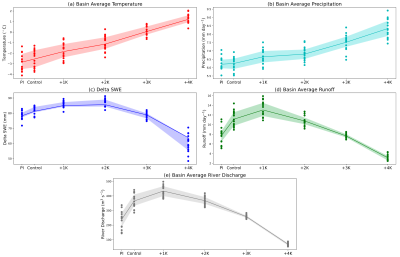The 1996 Mid-Atlantic Winter Flood: Exploring Climate Risk through a Storyline Approach
This research investigates the application of thermodynamic perturbations within the context of a historical compound extreme. In particular, we focus on the 1996 Mid-Atlantic rain-on-snow floods, aiming to assess how similar extremes might evolve under varying climate forcings. We hindcast the event with an ensemble of 14-km variable-resolution simulations using the Department of Energy's global Energy Exascale Earth System Model (E3SM) and the Betacast software package. The work demonstrates that E3SM and Betacast can replicate the 1996 flood event over the Susquehanna River Basin (SRB) through a comparison with in situ observational data and high-resolution reanalyses. We find that, as the atmosphere warms, a non-linear response occurs in flood risk, with increasing runoff and streamflow until approximately +2 degrees Celsius of warming, with a reduction after that. We discover this is due to competition between storm precipitation, atmospheric temperature, and available snow to melt as well as soil temperature and moisture.
The study highlights the potential nonlinear response in simulated surface runoff and streamflow with warming in a highly populated river basin in the eastern U.S. This nonlinearity is attributed to various factors, including changes in liquid water input due to shallower initial snowpacks, elevated surface temperatures, increased rainfall rates, and enhanced soil water storage. The results identify a critical temperature range (+1 to +2 degrees Celsius of global average surface warming) associated with peak flooding risk and highlight shifts in the timing of peak runoff and streamflow, affecting the event's flashiness. These insights have broad implications for climate risk assessment and adaptation strategies.
We explore a historical flood event with a 14km version of E3SM to explore the impacts of a warmer atmosphere on potential rain-on-snow floods in the northeastern United States. E3SM skillfully replicates the 1996 Mid-Atlantic flood over the Susquehanna River Basin. A nonlinear response in flood risk to atmospheric warming is discovered, arising from a variety of changes to the event's dynamical evolution. This research underscores the value of storyline approaches for communicating climate-related risks and emphasizes the presence of potential nonlinearities in hydrologic extremes in regions with ephemeral snowpacks.

